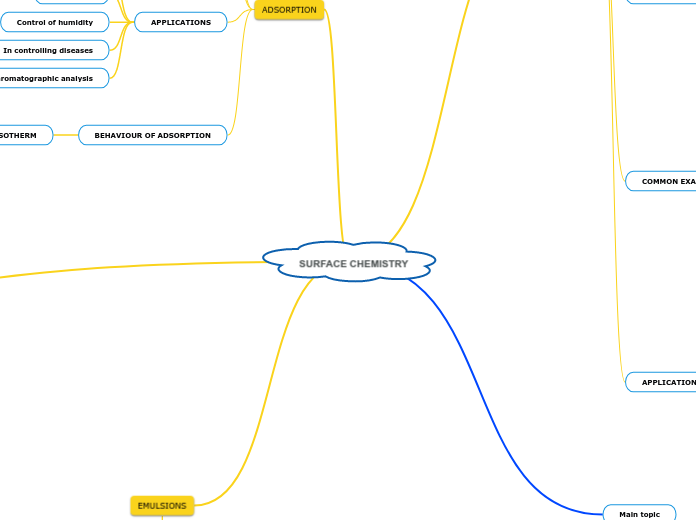
CLASSIFICATION
Based on physical state of Dispersed phase and Dispersion medium
Solid sol
Sol
Aerosol
Gel
Emulsion
Aerosol
Solid sol
Foam
Based on nature of interaction between dispersed phase and dispersion medium
Lyophilic colloids
Lyophobic colloids
Based on type of particles of the dispersed phase
Multimolecular colloids
Macromolecular colloids
Associated colloids( micelles)
PREPARATION
Bredig's Arc Method
Peptization
Chemical methods
PURIFICATION
Dialysis
Electrodialysis
Ultrafiltration
PROPERTIES
Colligative properties
Tyndall effect
Brownian movement
Colour
Charge on colloidal properties
Electrophoresis
Coagulation
COMMON EXAMPLES
Soils
Fog, mist, rain
Blue colour of sky
Food articles
Blood
Formation of delta
APPLICATIONS
Electrical precipitation of smoke
Purification of drinking water
Medicines
Tanning
Cleansing action of soaps & detergents
Photographic plates and films
Rubber industry
Industrial products
MECHANISM
The surface particles of the adsorbent are not in the same environment as the particles inside the bulk
TYPES
CHEMISORPTION
PHYSISORPTION
APPLICATIONS
Production of high vacuum
Gas masks
Control of humidity
In controlling diseases
Chromatographic analysis
BEHAVIOUR OF ADSORPTION
FREUNDLICH ADSORPTION ISOTHERM
x/m = k.P1/n (n > 1)
x/m=kC^(1/n) [Adsorption from solution phase]
TYPES
HOMOGENEOUS CATALYSIS
HETEROGENEOUS CATALYSIS
ENZYME CATALYSIS
SHAPE SELECTIVE CATALYSIS
CATALYSTS
TYPES
PROMOTERS
POISON
OIL IN WATER EMULSION
WATER IN OIL EMULSION